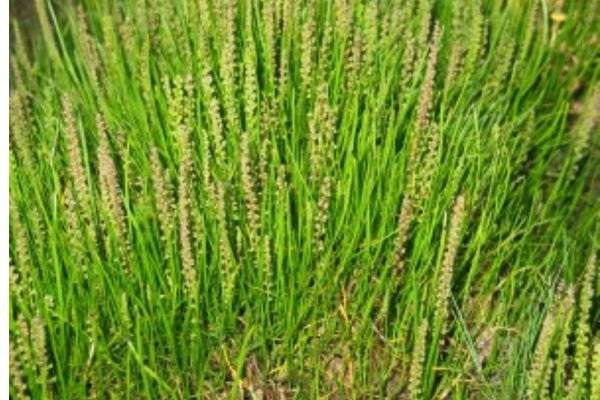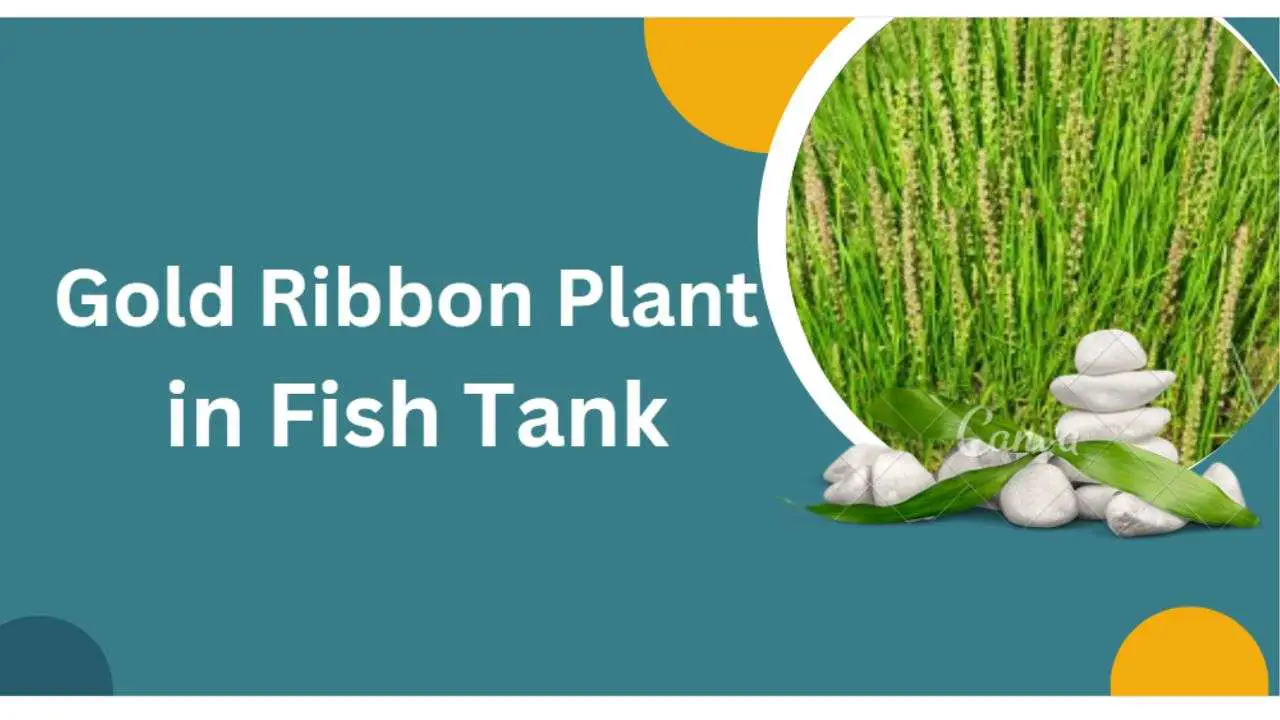The Gold Ribbon Plant, scientifically known as Triglochin striata, is a herbaceous perennial plant that belongs to the family Juncaginaceae. It is native to various parts of the world, including North America, Europe, Asia, and Australia. This plant is also commonly referred to as “Yellow Ribbon Plant” or “Stalked Arrowgrass” due to its distinctive appearance.
Here are some key details about the Gold Ribbon Plant (Triglochin striata):
Physical Characteristics
The Gold Ribbon Plant, scientifically known as Triglochin striata, is a botanical marvel characterized by a set of distinctive physical features:

Gold Ribbon Plant
Height: They can reach a height of up to 30-60 centimeters (12-24 inches).
Habitat: Gold Ribbon Plants are commonly found in freshwater or brackish wetlands. This species displays adaptability to a range of climatic conditions, from temperate to subtropical zones. They typically grow in wetlands, marshes, and along the edges of ponds or lakes and shallow waters. They are adapted to both terrestrial and aquatic environments.
It also thrives in both still and slow-moving waters, making it a versatile aquatic plant. Its native habitats span continents, including North America, Europe, Asia, and Australia. By recreating these conditions, you can foster its growth in your aquarium.
In their native habitats, Gold Ribbon Plants grow in soil that is often wet and muddy. They can tolerate periods of inundation and are well-suited to fluctuating water levels.
These plants typically receive ample sunlight in their natural habitats, thriving in areas with full to partial sun exposure.
Leaves: The leaves are linear or lance-shaped, and they are usually green or bluish-green in color adding a touch of freshness to any aquascape.. The most striking feature of the Gold Ribbon Plant is its long, ribbon-like leaves. The leaves are arranged alternately along the stems, creating a visually pleasing pattern.
These elegant, slender leaves can grow to be several inches in length, providing a graceful and delicate appearance. They are attached to long stalks that rise above the water surface.
Flowers: The plant produces tall, emergent flower spikes topped with small, inconspicuous greenish flowers that are arranged in spikes or racemes. These spikes rise above the water’s surface, adding an interesting dimension to their appearance. The flowers are unisexual, with male and female flowers on separate plants (dioecious).
Fruits: After pollination, Gold Ribbon Plants produce small, capsule-like fruits containing seeds.
Submerged Growth: Gold Ribbon Plants are primarily aquatic and are designed for submerged growth. This makes them an excellent choice for underwater landscapes in fish tanks and aquascapes.
Ecological Importance
- Gold Ribbon Plants play a role in stabilizing the soil in wetland ecosystems.
- They provide habitat and food for various aquatic and semi-aquatic wildlife, including waterfowl and insects.
- The presence of Gold Ribbon Plants can also help improve water quality in aquatic environments by filtering and removing excess nutrients.
Why Choose Gold Ribbon Plant for Your Fish Tank?
Its aesthetic charm aside, this plant contributes to the health of your aquatic ecosystem. With its oxygenating properties and ability to remove excess nutrients from the water, it creates an environment where both plants and fish thrive.
Varieties of the Gold Ribbon Plant Species
The Gold Ribbon Plant species encompasses several captivating varieties, each with its unique appeal:
- Triglochin striata var. striata: The classic Gold Ribbon Plant variety features long, green ribbon-like leaves with prominent striations. It’s a favorite choice among aquascapers for its elegant appearance.
- Triglochin striata ‘Tasmanian’: This variety hails from Tasmania and is known for its distinctive variegated leaves. The green and white coloration of the leaves adds a touch of contrast and uniqueness to aquariums.
- Triglochin striata ‘Ruby’: The ‘Ruby’ variety stands out due to its reddish-brown leaves. It provides a striking contrast to the usual green aquatic plants and adds a dash of color to your underwater landscape.
- Triglochin striata ‘Mini’: If you’re working with smaller aquariums or prefer a more compact Gold Ribbon Plant, the ‘Mini’ variety is a perfect choice. It retains the characteristic ribbon-like leaves but on a smaller scale.
Caring for Your Gold Ribbon Plant
Taking care of your Gold Ribbon Plant is essential to ensure its health and longevity in your aquarium. Here, we’ll delve into the maintenance and care guidelines to keep your aquatic masterpiece flourishing.
Routine Pruning and Trimming
Regular maintenance is key to maintaining the beauty and balance of your aquascape:
- Trimming Overgrowth: As the Gold Ribbon Plant grows, it may extend its elegant ribbon-like leaves, sometimes excessively. Periodic trimming helps maintain the desired aesthetic and prevents overcrowding.
- Removing Dead or Yellowing Leaves: Prune any dead or yellowing leaves promptly. These decaying leaves can release harmful substances into the water, affecting water quality.
Fertilization and Nutrient Requirements
Providing the right nutrients is crucial for the health and vibrancy of your Gold Ribbon Plant:
- Balanced Fertilization: Gold Ribbon Plants benefit from a balanced fertilization regimen. Use a high-quality aquatic plant fertilizer to supply essential nutrients like nitrogen, phosphorus, and potassium (NPK). Follow the product instructions carefully to avoid over-fertilization.
- CO2 Supplementation: Depending on your tank’s setup, consider CO2 supplementation. Adequate carbon dioxide levels can enhance plant growth. However, this is more relevant for advanced aquascapers.
- Nutrient Monitoring: Regularly monitor nutrient levels in your tank using test kits. Adjust your fertilization schedule accordingly to maintain optimal nutrient balance.
Dealing with Common Issues and Diseases
Addressing potential challenges promptly is crucial to a thriving aquarium:
- Algae Control: Algae can sometimes compete with Gold Ribbon Plants for nutrients and light. Maintain a consistent lighting schedule, implement proper nutrient management, and consider adding algae-eating fish or invertebrates to keep algae growth in check.
- Yellowing Leaves: Yellowing leaves can indicate nutrient deficiencies or lighting issues. Adjust your fertilization routine and lighting conditions as needed to remedy this problem.
- Pests: Keep an eye out for common aquatic pests like snails. If they become problematic, consider introducing snail-eating fish or manually removing them.
By adhering to these maintenance and care guidelines, you can ensure that your Gold Ribbon Plant not only thrives but also continues to contribute to the health and aesthetics of your aquarium. Regular attention to these factors will help you create a stunning underwater landscape that you can enjoy for years to come.
Harmonizing Gold Ribbon Plants with Aquarium Companions
Incorporating Gold Ribbon Plants into your aquarium involves more than their aesthetic appeal; it’s about creating a balanced aquatic community. Let’s explore the compatibility of Gold Ribbon Plants with various fish and tankmates, ensuring a harmonious coexistence.
Fish Species that Pair Well with Gold Ribbon Plants
Selecting fish that complement Gold Ribbon Plants is essential for a thriving aquascape:
- Peaceful Community Fish: Peaceful species like tetras, guppies, and rasboras generally coexist well with Gold Ribbon Plants. Their non-aggressive behavior reduces the risk of damage to the delicate leaves.
- Herbivorous Fish: Certain herbivorous fish, such as some species of cichlids and catfish, can be beneficial as they help control algae growth, enhancing the overall health of your aquatic ecosystem.
Caring for Gold Ribbon Plants in a Community Tank
In a community tank, the dynamics between various fish and tankmates can affect the well-being of your Gold Ribbon Plants:
- Provide Adequate Space: Ensure your tank offers enough space for fish to swim freely without disturbing the plants. Overcrowding can lead to accidental damage.
- Monitoring Behavior: Observe your fish’s behavior. Some species may be prone to nibbling on aquatic plants, while others may exhibit curious but harmless interactions.
Avoiding Potential Conflicts
Preventing conflicts and stress in your aquarium is vital for plant and fish health:
- Aggressive Fish: Avoid aggressive fish species known for uprooting plants or engaging in territorial disputes. Such behavior can harm Gold Ribbon Plants and disrupt your aquascape.
- Introduce Tankmates Gradually: When adding new fish or tankmates, do so gradually to reduce stress and aggression, which can inadvertently harm your plants.
Frequently Asked Questions (FAQs)
What water parameters do Gold Ribbon Plants prefer?
Answer: Gold Ribbon Plants thrive in slightly acidic to neutral water conditions. Aim for a pH range of 6.5 to 7.5 and maintain a water temperature between 72°F to 78°F (22°C to 26°C). They are adaptable to various water hardness levels but generally prefer soft to moderately hard water.
How can I prevent my Gold Ribbon Plants from becoming too tall and leggy?
Answer: To prevent excessive growth and maintain the desired height, regularly trim the plant’s ribbon-like leaves. Pruning encourages new growth and helps maintain the plant’s elegant appearance in your aquarium.
Can I use Gold Ribbon Plants in a low-tech or low-light aquarium setup?
Answer: Yes, you can include Gold Ribbon Plants in low-tech or low-light setups. While they do benefit from moderate to high lighting, they are adaptable and can thrive in lower light conditions. Just be prepared for slower growth and potentially more extended leaves.
Are Gold Ribbon Plants suitable for beginners in the world of aquascaping?
Answer: Gold Ribbon Plants are considered beginner-friendly. They are relatively easy to care for and can adapt to a range of conditions. Their unique appearance and low maintenance requirements make them an excellent choice for novice aquascapers.
Do Gold Ribbon Plants require CO2 injection for healthy growth?
Answer: While CO2 supplementation can enhance growth, it’s not a strict requirement for Gold Ribbon Plants. They can thrive in aquariums without CO2 injection, especially if you provide adequate lighting and nutrient-rich water. However, in high-tech setups, CO2 may boost their growth rate and overall vitality.
Wrapping Up
As we wrap up our exploration of Gold Ribbon Plants and their role in the captivating world of aquascaping, we hope you’ve gained valuable insights and inspiration to embark on your own underwater journey.
Gold Ribbon Plants, with their graceful ribbon-like leaves and unique charm, offer not only aesthetic appeal but also contribute to the health and balance of your aquarium. They are versatile, adaptable, and well-suited for both beginner and experienced aquascapers.
From understanding their origins and ideal conditions to nurturing their growth and maintaining a thriving aquatic ecosystem, we’ve covered it all. Whether you’re creating a natural biotope, a minimalist design, or a lush Dutch aquascape, Gold Ribbon Plants can play a starring role in your aquatic masterpiece.
As you venture into the world of aquascaping, remember that it’s not just about creating a visually stunning aquarium; it’s about crafting a living work of art beneath the water’s surface. With dedication, creativity, and the knowledge you’ve gained here, you can transform your fish tank into a mesmerizing underwater world.
So, don’t hesitate to dive in, experiment, and let your imagination flourish. Whether you’re a seasoned aquascaper or a curious beginner, the beauty and benefits of Gold Ribbon Plants await you beneath the tranquil waters of your own aquatic oasis. Happy aquascaping!

